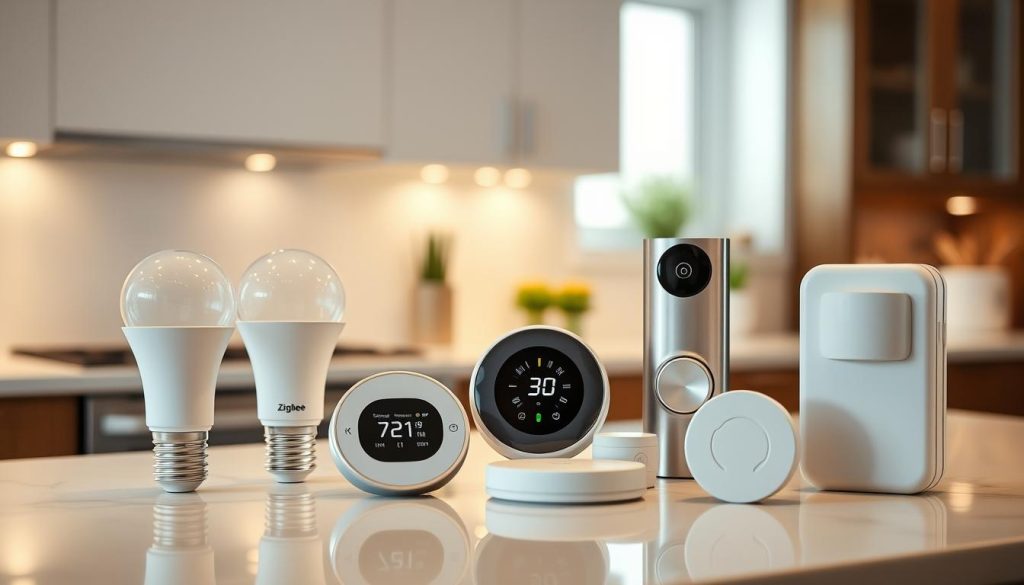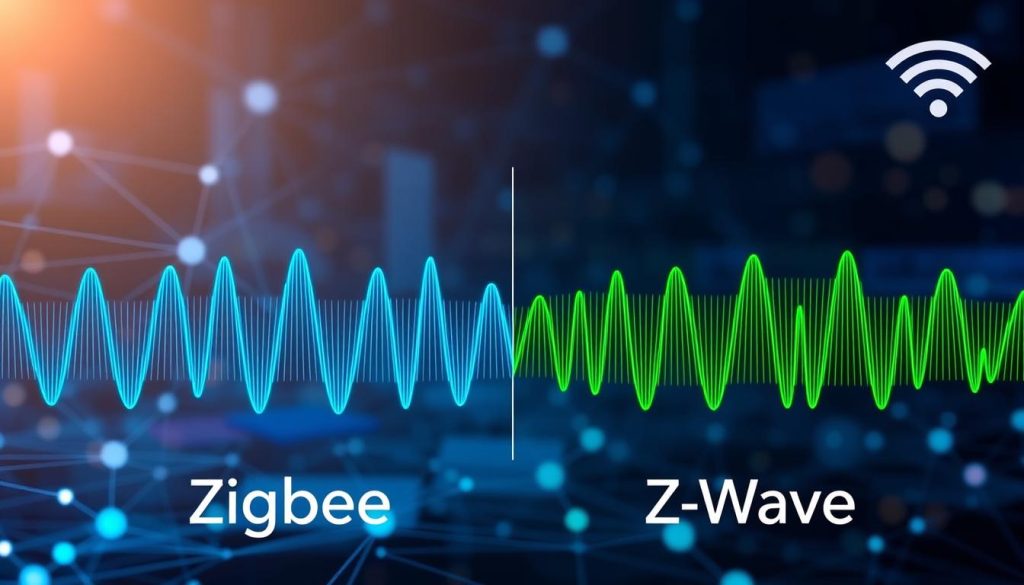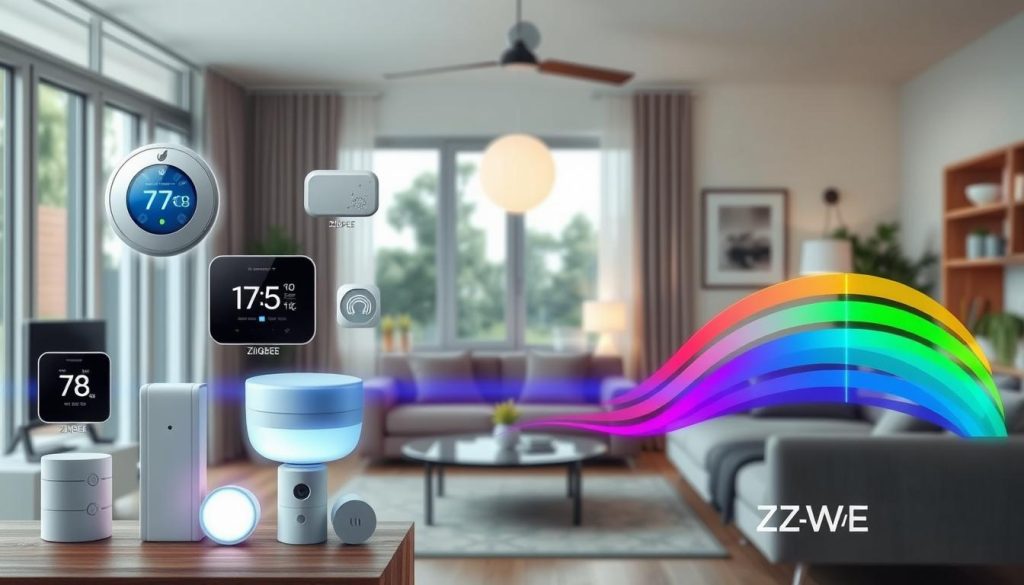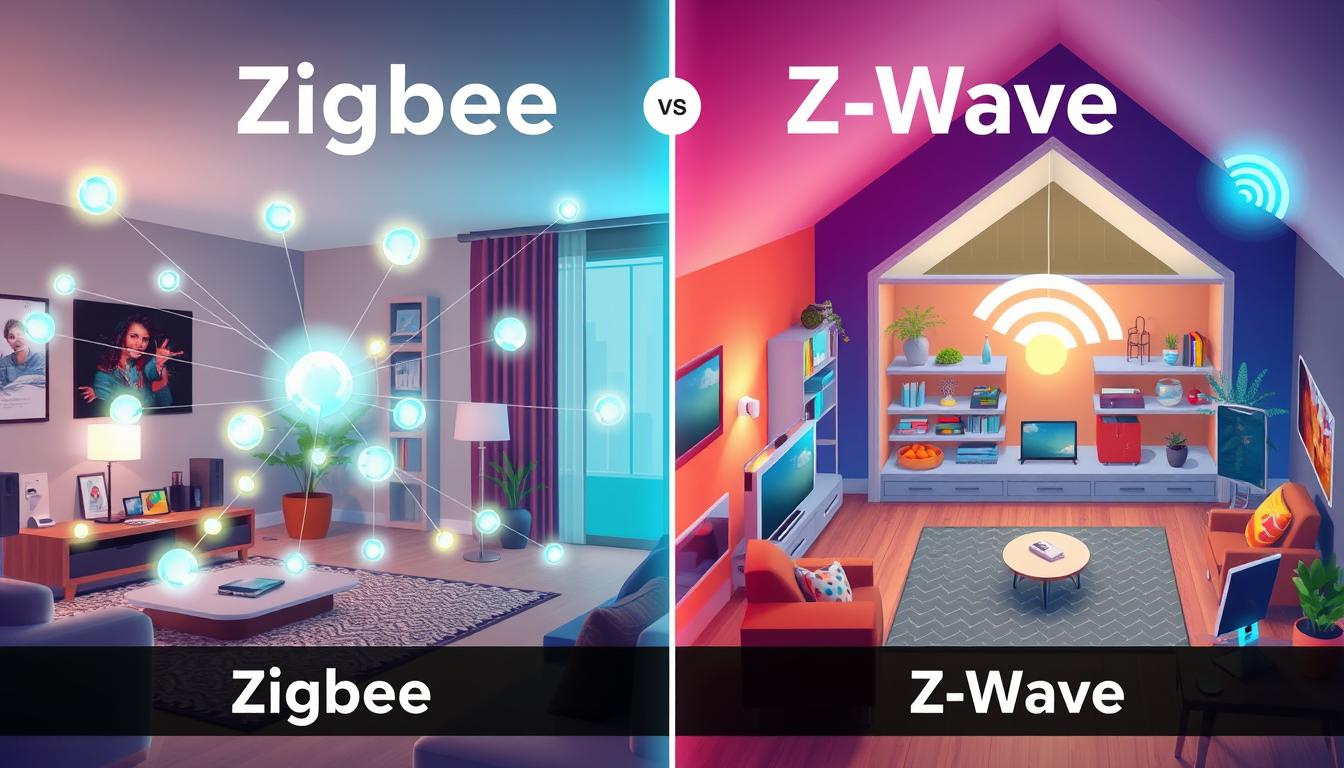I’m excited to share my knowledge on smart home technology. Specifically, I’ll dive into the Zigbee vs. Z-Wave debate. This article will give you a detailed look at these two popular wireless protocols.
With more people wanting smart home devices, knowing the difference between Zigbee and Z-Wave is key. This article aims to help you make a smart choice for your home automation setup.
We’ll look at the benefits of smart home devices and explore what makes Zigbee and Z-Wave special. This comparison will help you pick the right smart home technology for your needs. Whether you want to control your home’s lighting, temperature, or security, this guide will help you choose between Zigbee and Z-Wave.
Overview of Smart Home Automation Technologies
I’m excited to share my findings on smart home devices. They can make our living spaces better. The rise of IoT devices makes it easier to create a connected home.
Home automation uses technology to control and monitor our homes. This includes lighting, temperature, security, and entertainment. Smart home devices help make this experience seamless.
What is Home Automation?
Home automation makes our lives easier and more convenient. It lets us control and monitor our homes remotely. This ensures everything runs smoothly and efficiently.
Benefits of Smart Home Devices
Smart home devices offer many benefits. Some key advantages include:
- Increased convenience: We can control our home’s systems with just a few taps on our smartphones.
- Energy efficiency: Smart devices can reduce energy use by turning off lights and appliances when not needed.
- Enhanced security: They provide real-time monitoring and alerts, giving us peace of mind when away.
Understanding Zigbee
Zigbee is a key wireless standard for home automation and IoT devices. As a member of the Zigbee alliance, I’ve seen its benefits firsthand. It’s great for smart homes because it uses very little power.
The Zigbee alliance has created wireless protocols for easy device communication. These protocols are low-cost, low-power, and simple to use. They’re ideal for home automation. You’ll find Zigbee in smart light bulbs, thermostats, and security cameras.

Choosing a wireless protocol for your smart home is crucial. Zigbee offers several advantages. Here are a few:
- Low power consumption: Zigbee devices are energy-efficient, perfect for devices needing little power.
- Easy to use: Zigbee devices are straightforward to install and operate. They’re great for those who want to automate their homes easily.
- Low cost: Zigbee devices are more affordable than other options. This makes them a budget-friendly choice for home automation.
Zigbee is a reliable and efficient wireless protocol for home automation. Its low power use, simplicity, and affordability make it popular among homeowners.
Understanding Z-Wave
Z-Wave is a wireless standard for home automation and IoT devices. As a member of the Z-Wave Alliance, I know how reliable and compatible Z-Wave devices are. They work well with many home automation systems.
Z-Wave uses the 908 MHz frequency band in the US. This allows it to reach up to 30 meters. It’s perfect for home automation because it supports many devices without getting in the way.
Definition and Key Features
Z-Wave devices are designed to be simple to use and fit into your home automation system. They are known for their reliability, low interference, and ability to handle lots of devices.
Popular Z-Wave Devices
Some well-known Z-Wave devices are smart thermostats, door locks, and lighting systems. You can control them from your smartphone or tablet. This makes managing your home automation system easy.
Advantages of Z-Wave
Z-Wave has many benefits. It’s reliable, has low interference, and can handle lots of devices. Plus, it works with many home automation systems. This makes it easy to add Z-Wave devices to your setup.
Here are some benefits of using Z-Wave devices in your home automation system:
- High reliability and low interference
- Ability to support a large number of devices
- Compatibility with a wide range of home automation systems
- Easy to use and integrate with existing systems
Key Differences Between Zigbee and Z-Wave
When we talk about home automation, Zigbee and Z-Wave are often mentioned. They are two popular wireless protocols. One key difference is the frequency band they use.
Zigbee works on the 2.4 GHz band, while Z-Wave uses 908 MHz in the US. This affects their range and how well they work with other devices. Here are some important points to remember:
- Zigbee has a shorter range and can get more interference
- Z-Wave has a longer range and less interference

Both protocols have their own strengths and weaknesses when it comes to network topology and scalability. The debate between Zigbee and Z-Wave is common among those who love home automation. Knowing the differences helps you make a better choice for your smart home.
Reliability and Performance Comparison
Reliability and performance are key when it comes to smart home tech. I’ll look at how Zigbee and Z-Wave affect IoT devices in a smart home. This will help us understand their impact on performance.
Interference and Obstacles
Zigbee can get disrupted by other devices, which hurts its performance. On the other hand, Z-Wave is less likely to be affected by interference. This makes Z-Wave a better choice for smart homes. But, the best option depends on the devices you use and your home’s layout.
Network Stability
A stable network is vital for smooth communication between devices. Z-Wave devices usually have a more stable network. But, they might cost more than Zigbee devices. Here’s a quick comparison of Zigbee and Z-Wave:
| Protocol | Interference | Network Stability | Cost |
|---|---|---|---|
| Zigbee | More prone to interference | Less stable network | Less expensive |
| Z-Wave | Less prone to interference | More stable network | More expensive |

In conclusion, choosing between Zigbee and Z-Wave depends on your specific needs. Think about interference, network stability, and cost. This will help you make the right choice for your smart home technology and IoT devices.
Power Consumption: Zigbee vs. Z-Wave
Energy efficiency is key when choosing smart home devices. Both Zigbee and Z-Wave are designed to save energy. But, Zigbee devices usually use less power than Z-Wave ones.
Battery Life Considerations
Battery life is important for devices that run on batteries. Zigbee devices last longer because they use less power. This means you won’t need to replace their batteries as often.
Energy Efficiency
Both Zigbee and Z-Wave aim to use less power. But, Zigbee is a bit more efficient. This makes Zigbee a better choice for saving energy and cutting costs.
Here is a comparison of the power consumption of Zigbee and Z-Wave devices:
| Device Type | Power Consumption | Battery Life |
|---|---|---|
| Zigbee | Low | Long |
| Z-Wave | Medium | Medium |

Compatibility with Smart Home Systems
When you add devices to your smart home, making sure they work together is key. Both Zigbee and Z-Wave devices fit well with many smart home systems. This includes big names like Samsung SmartThings and Wink.
Before you buy, check if your devices will work together. Look up the device’s details or visit the maker’s website for info.
Integrating Zigbee with Your Devices
Zigbee devices are easy to find in smart homes. They’re great for controlling lights, temperature, and even security cameras.
Integrating Z-Wave with Your Devices
Z-Wave devices are also popular. They use less power and send signals reliably. You can find them in door locks, garage openers, and hubs.
Here are some top smart home systems that work with these devices:
- Samsung SmartThings
- Wink
- Apple HomeKit
- Google Home
Security Features of Zigbee and Z-Wave
Exploring smart home automation, I see how vital security is. With more IoT devices, keeping our homes safe is key. It’s important to protect our systems from threats.
Zigbee and Z-Wave use encryption to keep data safe. Zigbee uses AES-128, while Z-Wave uses AES-128 and TLS. These standards help keep our smart homes safe from hackers.
Encryption Standards
Encryption is crucial for our smart homes. It keeps our data safe from prying eyes. We also need strong passwords and keep devices updated.
Vulnerabilities and Risks
Even with security, Zigbee and Z-Wave face threats. They’ve been hacked before. We must stay vigilant and update our systems to stay safe.
To boost security, we need to use many measures. This includes encryption, strong passwords, and updates. By being proactive, we can keep our smart homes safe and reliable.
| Protocol | Encryption Standard | Vulnerabilities |
|---|---|---|
| Zigbee | AES-128 | Hacking and cyber attacks |
| Z-Wave | AES-128 and TLS | Hacking and cyber attacks |
Cost Considerations
Choosing between Zigbee and Z-Wave for your smart home is all about cost. As someone who loves smart home tech, I’ve found that setup and maintenance costs differ a lot. These costs can affect your budget.
Zigbee devices are often cheaper, costing between $20-$50 each. But, Z-Wave devices might need pricier hubs and controllers. This can make your system more expensive overall.
Initial Setup Costs
Setting up your smart home includes buying devices, hubs, and controllers. Here’s what to think about:
- Device costs: Zigbee is usually cheaper than Z-Wave.
- Hub and controller costs: Z-Wave might need more expensive ones.
- Installation costs: Setup costs can vary based on how complex it is.
Long-term Maintenance Costs
Maintenance costs over time include replacing devices, updating software, and fixing problems. Here are some points to consider:
Smart home costs can be complex. Thinking about setup and maintenance helps you choose wisely. This way, you can find the best fit for your budget and needs.
By picking the right smart home tech, you can have a convenient, efficient, and safe home. And you can do it without breaking the bank.
| Technology | Initial Setup Costs | Long-term Maintenance Costs |
|---|---|---|
| Zigbee | $20-$50 per device | Lower maintenance costs due to device replaceability |
| Z-Wave | $50-$100 per device | Higher maintenance costs due to device complexity |
Future Trends in Home Automation
Looking ahead, I’m thrilled about the advancements in smart home tech. IoT devices are leading the way, making devices and systems more flexible and compatible. This means homeowners can enjoy a seamless, connected experience with all their devices working together.
The future of Zigbee and Z-Wave is also exciting. These protocols will become more energy-efficient, reliable, and secure. This makes them even more appealing to homeowners. Some key trends to watch include:
- Increased adoption of artificial intelligence and machine learning to improve smart home automation
- Greater emphasis on energy efficiency and sustainability in smart home technology
- More devices and systems that integrate multiple protocols, such as Zigbee and Z-Wave
As smart home tech evolves, these trends will shape the future. With IoT devices becoming more popular and the demand for smart home automation growing, it’s an exciting time.
These trends bring many benefits. They improve convenience, increase energy efficiency, and enhance security. For instance, artificial intelligence and machine learning can adjust lighting, temperature, and security settings based on a homeowner’s preferences. This makes life easier, reduces energy use, and boosts safety.
| Trend | Benefit |
|---|---|
| Artificial Intelligence | Improved convenience and energy efficiency |
| Energy Efficiency | Reduced energy consumption and lower utility bills |
| Multi-Protocol Integration | Greater flexibility and compatibility with different devices |
The future of smart home technology is bright and full of possibilities. With IoT devices and the evolution of Zigbee and Z-Wave, we can expect big changes. As a homeowner, staying informed about these trends can greatly enhance your smart home experience.
Making the Right Choice for Your Home Automation
Choosing between Zigbee and Z-Wave for your smart home is key. Think about range, interference, cost, and compatibility. These factors are important, as I’ve explained in this article. The best choice for you depends on your specific needs.
Z-Wave is great for long-range connectivity and works with many devices. It also uses less energy. But, Zigbee is better for network stability, growing your system, and security. Decide which features you need most for your smart home.
Home automation is always changing, and both Zigbee and Z-Wave are leading the way. By choosing wisely, you can make your home more efficient and secure. This will improve your life and bring your home into the digital age.


